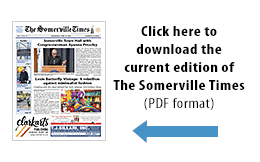
By Joseph A. Curtatone
(The opinions and views expressed in the commentaries of The Somerville News belong solely to the authors of those commentaries and do not reflect the views or opinions of The Somerville News, its staff or publishers.)
It wasn’t that long ago – as recently as 2005 – when there were only four ways to get the word out in an emergency like this week’s heat wave.
In those days, the method with the most reach and impact was to issue a press release (#1). Newspapers, radio and television would then decide whether or not to broadcast some version of your message for you. And, if you were lucky, they’d send people who needed more information to your website (#2). Residents in the know could also call a phone line, 617-628-SNOW (7669), to get a recorded message with updated information (#3). Of course, back then we called it the Snow Emergency Hotline, and we rarely used at other times of year. We were also just beginning to make good use of a mass distribution email list that provided snow emergency information to residents who’d signed up for the service (#4) .
Today, when we declare a snow emergency or issue a heat advisory, the word goes out over no less than nine different channels. The Information Hotline is still there, but mostly people dial it when it appears in their caller ID screen because they’ve received a call from our mass notification system (#5) – a service we’ve been using since the spring of 2006. That same system also lets us provide SMS text messages (#6) to those who prefer their notifications in that format – and it lets us send email notifications to anyone who subscribes to them. Some residents sign up for all three channels – and we appreciate it when they do.
Perhaps our most potent and popular channel (certainly our most useful when it comes to collecting and managing data) is the 311 constituent service system (#7). Residents know that – twenty-four hours a day and seven days a week – they can call 311 from any landline or cell phone in the city (617-666-3311 from beyond the city limits), and get up-to-the-minute information in multiple languages concerning city services, events or announcements. (They can also file a request for service and receive a work order tracking number that lets them track the progress and outcome of their request either on the phone or on the city website.)
311 is one of the cornerstones of our city’s data-driven management system, and a crucial way for us to know not only what services our residents need but also how well we’re doing when it comes to providing those services on a timely and cost-effective basis.
But when it comes to getting the word out, 311 has been watching over the past couple of years as Facebook (#8) and Twitter (#9) come up fast in the rear view mirror. Social media has provided a powerful new way for us to deliver real-time information and interact directly with residents. It’s even become a favorite method for residents to interact with 311, which has its own Facebook page and Twitter feed.
Of course, there will always be room for improvement, and we continue to look at new ways to get the word out and help residents stay in touch with their city government. For example, there have been advances in translation services that would let us send out mass notification phone messages in multiple languages, but we can’t take full advantage of that capability until we develop more effective outreach to communities that want to give us their emails and phone numbers so they can receive messages in Spanish or Portuguese or Haitian Creole. Future versions of mass notification technology may also give us the ability to fold our Information Hotline and even some of our social media feeds into a single integrated package that will make all of our communications programming more efficient and less time-consuming.
But even as we look for ways to continue the improvement and expansion of our interactive communications systems, it’s still worth taking a look back at how far we’ve come in just a few short years.
Somerville has a long history of innovation in communications – the first private telephone in America was installed right here in Somerville (and yes, the phone number, in its entirety, was “1”) – but that history has really taken off in just the past decade. The messages that city government needs to deliver – about road closures, water main breaks, hydrant flushing, weather emergencies and public safety advisories – haven’t changed much, but the speed and range of our delivery methods have grown exponentially.
It’s hard to imagine the technological changes we’ll be seeing over the next few years. But if they make Somerville a better place to live, work, play and raise a family, you can be sure that we’ll embrace them.















Reader Comments